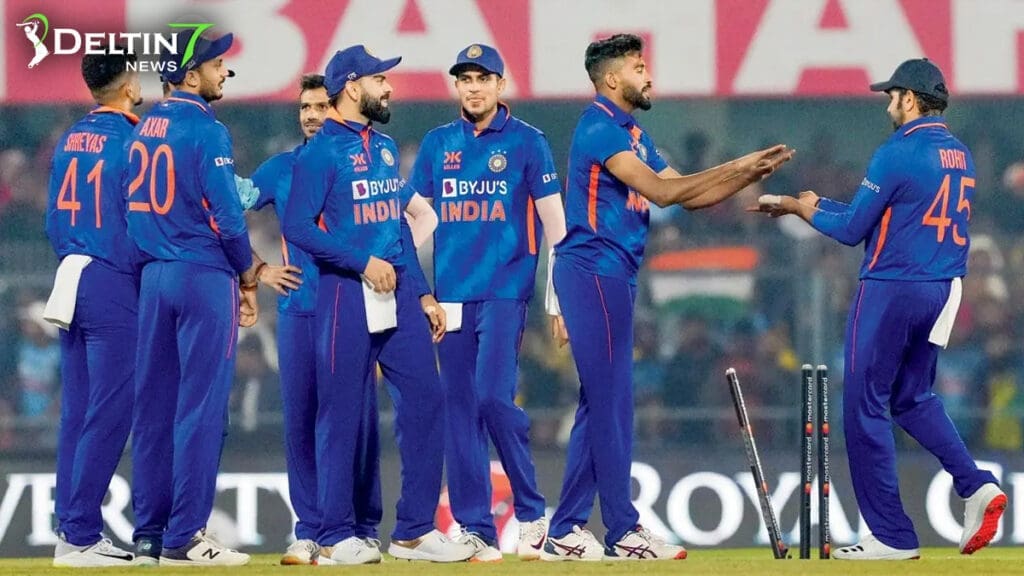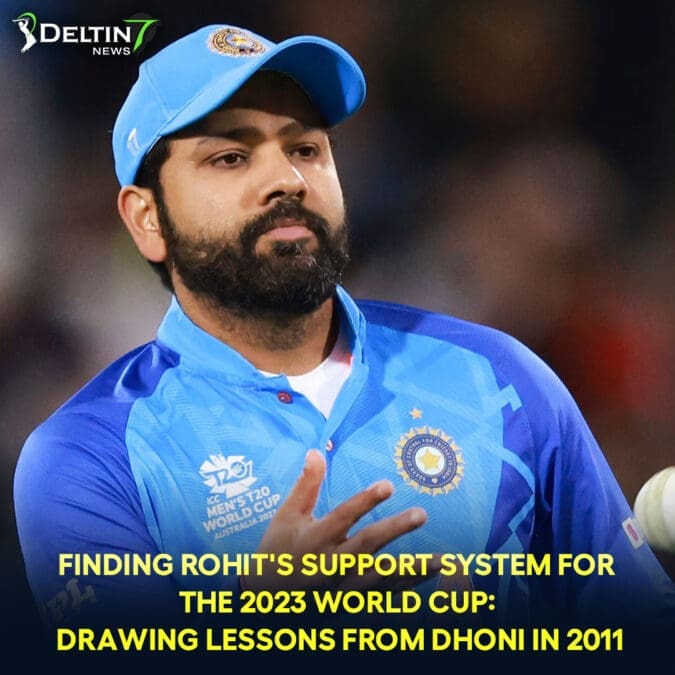
Support System for WC 2023
Leading up to the 2011 World Cup, India was not an invincible team, but they had players who were capable of stepping up in crucial moments and performing exceptionally well. Rohit Sharma’s team aspiring for championship success could benefit from studying the strategies employed by Dhoni’s victorious World Cup team.
Nearly 10 months prior to the 2011 World Cup, three South Africans sitting at a hotel breakfast table in Sri Lanka came to a harsh conclusion: India lacked what it took to win the tournament. Armed with this brutally honest assessment, coach Gary Kirsten and his assistants Eric Simmons and Paddy Upton developed a meticulously researched action plan that culminated in MS Dhoni launching the ball into the enchanting Wankhede night sky on April 2nd.
In just 10 weeks, India will once again indulge in dreams of success. A nation, filled with nervous hope, will ponder an intriguing question: Can Rohit Sharma replicate the accomplishments of Dhoni? If Rahul Dravid raises this million-dollar question to his coaches over a candid breakfast conversation in the West Indies, he might receive a disappointing response. With limited time remaining for the tournament, Ajit Agarkar, the new head selector, along with Dravid and Rohit themselves, may find value in studying the journey and experiences of the Class of 2011 for valuable insights and inspiration.
The composition of India’s playing XI is like an incomplete puzzle, and Rohit Sharma’s team currently lacks the aura of a championship team. The playing XI for India appears to be far from settled. Factors such as the form of key players, fitness concerns regarding potential World Cup participants recovering at the National Cricket Academy, and a disappointing track record in recent ICC events prevent us from declaring India as the undisputed favorite to win the World Cup.
Indian cricket is not lacking in options. There are several players who have either recovered or are recovering from injuries but were not selected for the West Indies tour. Jasprit Bumrah, R Ashwin, KL Rahul, Shreyas Iyer, Mohammad Shami, Prasidh Krishna, along with Yashasvi Jaiswal, who recently made his Test debut – they all add to the talent pool that India has at this World Cup. However, the real challenge lies in selecting a balanced squad that is mentally strong and not overly dependent on a few players. The squad needs to be adaptable and capable of adjusting their form in this long tournament full of surprises and unpredictable twists.
Reference point
To get an idea of what the ideal Tournament Team looks like, just check out the scoreboard from the 2011 India vs Australia quarter-final. The team sheet for that game had the following lineup: Sehwag, Tendulkar, Gambhir, Kohli, Dhoni, Raina, Ashwin, Harbhajan, Zaheer and Munaf. In this crucial knockout match, India made a bold move by making a course correction. With their squad boasting both variety and experience, they had the courage to switch to Plan B for their first knockout game.
In the last six league games, India had consistently relied on all-rounder Yusuf Pathan. Similar to Hardik Pandya now, Pathan was considered the team’s go-to player for various roles. He could bowl in the powerplay and with both new and old balls. He also excelled as a big-hitting batsman, taking on the role of a pinch-hitter, disruptor, and finisher. However, despite being given multiple opportunities, Pathan couldn’t make a significant impact on the game. This gamble was starting to prove unsuccessful.
In the Australia game, Team India showed confidence by selecting Ashwin and Raina, even though they had only played one of the six league games. Over the course of 10 months, Kirsten and Dhoni had prepared themselves for any situation. They closely observed every player in high-pressure scenarios and didn’t shy away from taking risks. Each player had been tested and proven themselves capable. Leaders of experienced teams embrace change without hesitation.
Flexible templates
During the 2011 World Cup, the Indian cricket team showcased their versatility by successfully adapting to various team compositions throughout the tournament. In their nine matches, they strategically chose between line-ups consisting of ‘three pacers, one spinner, and two all-rounders’, ‘two pacers, two spinners, and two all-rounders’, or ‘two pacers, two spinners, and one all-rounder’. Additionally, Captain Dhoni had the advantage of utilizing occasional bowlers within the squad. Notably, Sachin Tendulkar and Virat Kohli contributed with a few overs when needed while Suresh Raina’s off-breaks against left-handed batsmen proved valuable in complementing the frontline spinners.
In the crucial match against Australia, India made a strategic decision by not including Yusuf in the team for the first time in the tournament. Instead, they divided his role between Ashwin and Raina. With only two pacers, Zaheer and Munaf, Ashwin was entrusted with opening the bowling. Raina took charge of the middle-order batting. Lacking any nerves or hesitation, Ashwin immediately made an impact by dismissing opener Shane Watson. It is widely recognized among cricket enthusiasts that removing Watson from a knockout match carries significant importance.
Meanwhile, Raina played an outstanding inning that coach Kirsten would praise for days and years. Alongside Yuvraj, he successfully guided India to victory in a tense chase. This accomplishment is something that even some of India’s greatest batsmen have failed to achieve in ICC events. In a team featuring legends like Tendulkar, Sehwag, Gambhir, and Kohli, it was Raina and Yuvraj who stepped up when the team found themselves in a precarious position with five wickets down and needing 74 runs at almost six runs per over. And all this happened against Australia in the World Cup.
During a corporate speech in 2017, Kirsten praised Suresh for his outstanding performance in the World Cup. Specifically, she highlighted his crucial innings against Australia in the quarterfinals which ultimately led to victory. Despite having played only one game prior, Suresh showcased immense responsibility and maturity with his exceptional gameplay. This achievement was a result of years of experience, during which he made mistakes but also learned valuable lessons along the way.
In his book ‘The Test of my Life,’ Yuvraj recounts the memorable partnership between himself and Raina. He vividly remembers how Raina faced a barrage of short balls from the Australian bowlers but managed to survive. Throughout the intense match, the Australians taunted Raina, but Yuvraj intervened to prevent any confrontation. “For the first time in 12 years, Australia was knocked out of the World Cup. They may have won three titles before, but not this one. We secured victory with two overs to spare – no frantic rushing or struggling. It was a calm, meticulous, and clinical performance, all while enduring the mounting tension and escalating verbal exchanges from our opponents,” writes Yuvraj.
In order to have a successful campaign in 2023, India will need to identify players who can step up and perform exceptionally well, similar to Raina and Ashwin. However, winning the World Cup is no easy feat. As Yuvraj’s book illustrates, a championship team also requires experienced players who can inspire and be inspired by their teammates.
Words of inspiration
In an emotionally resonant scene from ‘The Test of my Life’, Yuvraj finds himself in a state of despair when he receives a dinner invitation from Tendulkar. This unexpected interaction would prove to be a turning point in Yuvi’s journey, ultimately leading him to greatness and earning him the esteemed title of Man of the Tournament. It all started with a simple yet profound suggestion from Tendulkar: “Play this tournament as a tribute to someone you hold dear, respect deeply, or who has significantly impacted your life. Let the World Cup become your way of fulfilling that debt.”
Yuvi didn’t have to search far for inspiration. He chose to play the World Cup for Tendulkar. To keep himself motivated, he affixed two pictures of Tendulkar playing his signature on-drive stroke onto his kit bag. Every time he reached for his bat, those images served as a constant reminder of his goal.
In the semifinal match against Pakistan, there was another unexpected standout performer: Ashish Nehra. He played a crucial role by taking two important wickets and ended up being the most impactful bowler of the game. Following closely behind Nehra was Munaf Patel, who also performed exceptionally well. In the final, it was Gautam Gambhir’s outstanding performance that truly shaped Dhoni’s rise to legendary status.
Let me take a shot at improving the readability of the given examples: 1. Original: The communication problems that endanger marriage can’t be fixed by mechanical engineering. They require a new conceptual framework about the role of talk in human relationships. Many of the psychological explanations that have become second nature may not be helpful because they tend to blame.













